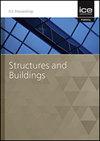Multihazard Response of Unbonded Fiber-Reinforced Elastomeric Isolator-Isolated Structures
IF 1.4
4区 工程技术
Q3 CONSTRUCTION & BUILDING TECHNOLOGY
Proceedings of the Institution of Civil Engineers-Structures and Buildings
Pub Date : 2022-11-17
DOI:10.1680/jstbu.22.00170
引用次数: 1
Abstract
Unbonded Fiber-reinforced Elastomeric Isolator (UFREI) as laminated elastomeric isolator is a relatively new approach to base-isolation devices with improved efficiency, cost-effectiveness, and ease. Base-isolated structures also become more susceptible to wind loads due to an increase in the period of the structure, and UFREIs have been found to be effective in mitigating occasional wind loads on isolated structures with the help of supplemental devices. This study investigates the multi-hazard response of the benchmark structures isolated using UFREIs under several hazards over a period of time. Hazard timelines consisting of probable prominent seismic and long-term wind events are generated for the analysis. Since fiber layers in UFREI are flexible in bending, the bond strength demand between elastomer and fiber layer decreases by a huge margin which delays any delamination failure. Thus, fatigue losses in the elastomer layers are used to characterize the damage induced in the UFREI due to multiple hazards throughout the timeline. Maximum principal strain in elastomer layers at various displacement amplitudes is calculated using finite element modeling, and it is further used to characterize the fatigue damage in elastomer layers. The final fatigue life of the designed UFREI is predicted using the obtained damage indices.非粘结纤维增强隔震弹性体隔震结构的多危害响应
非粘合纤维增强弹性隔离器(UFREI)作为层压弹性隔离器是一种相对较新的基础隔离装置,具有更高的效率、成本效益和便利性。由于结构寿命的增加,基础隔离结构也变得更容易受到风荷载的影响,并且已经发现ufrei在辅助装置的帮助下可以有效地减轻隔离结构上偶尔的风荷载。本研究调查了在一段时间内使用UFREIs隔离的基准结构在几种危害下的多危害响应。由可能的突出地震和长期风事件组成的危险时间线生成用于分析。由于UFREI中的纤维层在弯曲时是柔性的,因此弹性体与纤维层之间的粘结强度要求大大降低,从而延迟了分层失效。因此,弹性体层的疲劳损失用于表征UFREI中由于整个时间轴上的多种危害而引起的损伤。利用有限元模型计算了弹性体层在不同位移幅值下的最大主应变,并以此来表征弹性体层的疲劳损伤。利用得到的损伤指标预测了设计的UFREI的最终疲劳寿命。
本文章由计算机程序翻译,如有差异,请以英文原文为准。
求助全文
约1分钟内获得全文
求助全文
来源期刊
CiteScore
3.40
自引率
6.20%
发文量
61
审稿时长
12 months
期刊介绍:
Structures and Buildings publishes peer-reviewed papers on the design and construction of civil engineering structures and the applied research associated with such activities. Topics include the design, strength, durability and behaviour of structural components and systems.
Topics covered: energy conservation, people movement within and around buildings, strength and durability of steel and concrete structural components, and the behaviour of building and bridge components and systems

 求助内容:
求助内容: 应助结果提醒方式:
应助结果提醒方式:


